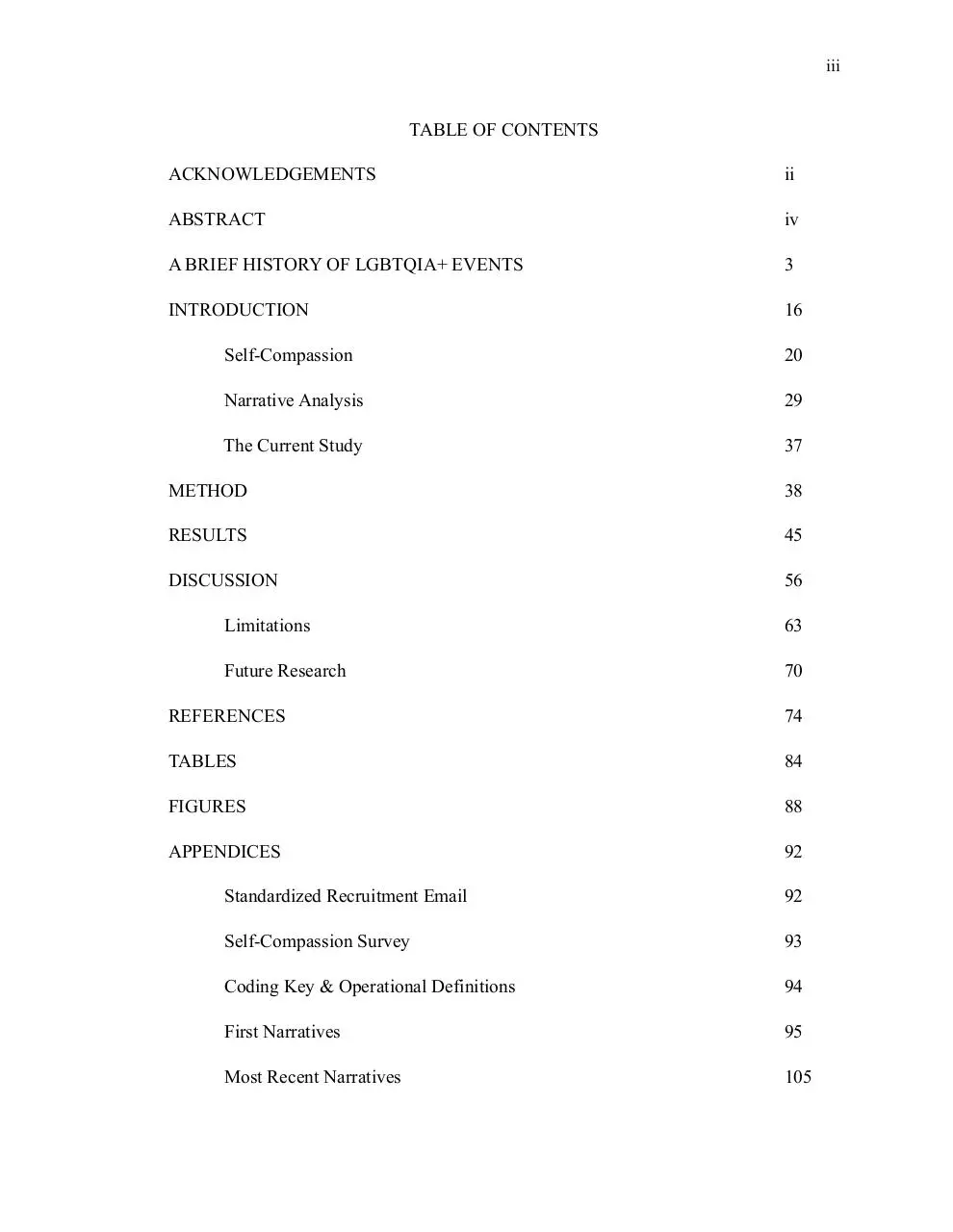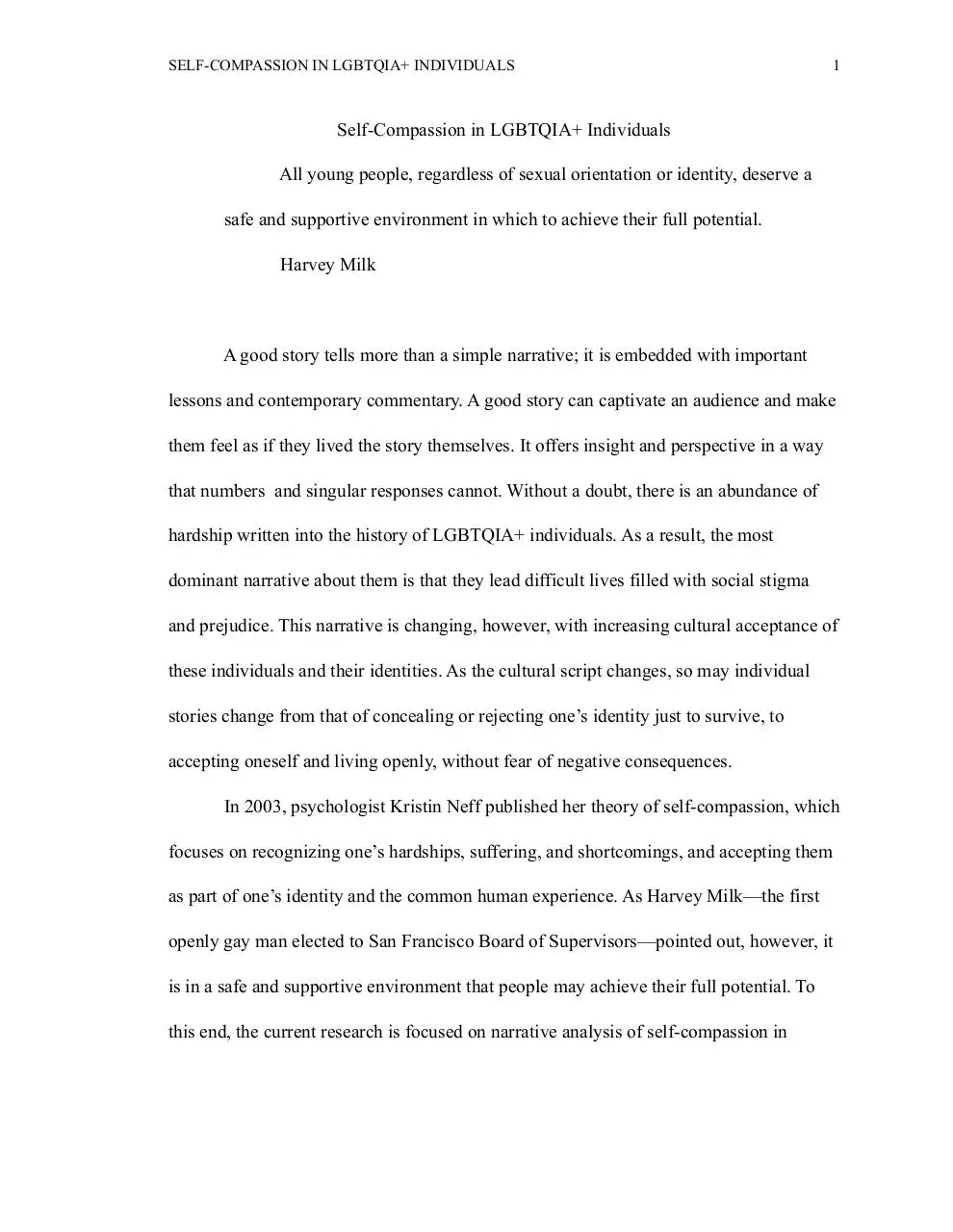Self Compassion in LGBTQIA+ Individuals (PDF)
File information
Title: Self-Compassion in LGBTQIA+ Individuals
Author: Constantine Michael Dhonau
This PDF 1.3 document has been generated by Pages / Mac OS X 10.6.8 Quartz PDFContext, and has been sent on pdf-archive.com on 29/05/2015 at 04:45, from IP address 24.144.x.x.
The current document download page has been viewed 639 times.
File size: 659.04 KB (113 pages).
Privacy: public file





File preview
SELF-COMPASSION IN LGBTQIA+ INDIVIDUALS
BY
CONSTANTINE DHONAU
A Thesis
Submitted to the Division of Social Sciences
New College of Florida
in partial fulfillment of the requirements for the degree
Bachelor of Arts (Single space all of this)
Under the sponsorship of Dr. Steven Graham
Sarasota, Florida
May, 2015
ii
Acknowledgments
This thesis is dedicated to the women who raised me
Bonnie “mom” Dhonau & Patti “aunt” Gentry
and the culmination of efforts it took from me, new friends, old friends, family, faculty,
administration, the LGBTQIA+ community, and forces beyond.
A special thanks to
Kat, for your love.
Bobby - Qake - Jackson - Andrew - Dad
Dr. Graham - Dr. Cottrell - Dr. Barton
for your faith.
These any many other people, and the great many ideas that came with them, by them, or
through them, are all beams of light which will warm my cold days.
...thank you all for enriching my Experience.
iii
TABLE OF CONTENTS
ACKNOWLEDGEMENTS
ii
ABSTRACT
iv
A BRIEF HISTORY OF LGBTQIA+ EVENTS
3
INTRODUCTION
16
Self-Compassion
20
Narrative Analysis
29
The Current Study
37
METHOD
38
RESULTS
45
DISCUSSION
56
Limitations
63
Future Research
70
REFERENCES
74
TABLES
84
FIGURES
88
APPENDICES
92
Standardized Recruitment Email
92
Self-Compassion Survey
93
Coding Key & Operational Definitions
94
First Narratives
95
Most Recent Narratives
105
iv
SELF-COMPASSION IN LGBTQIA+ INDIVIDUALS
Constantine Dhonau
New College of Florida, 2015
ABSTRACT
Self-compassion is a growing area of study which has yet to be applied to
LGBTQIA+ individuals. The current study seeks to fill this gap in knowledge by
examining the relationships between LGBTQIA+ individuals’ levels of self-compassion,
how they write about negative experiences based on their sexual and/or gender identity,
and their level of involvement in supportive communities. Participants wrote narrative
responses about their first and most recent negative experiences disclosing their
LGBTQIA+ identities to others, followed by the Self-Compassion Scale, which is
centered on being kind to oneself in instances of failure, perceiving one’s experiences as
part of the larger human experience, and holding painful feelings in mindful awareness.
Researchers expected a global, overall increase in self-compassion words from first to
most recent experience, and that level of involvement in a supportive community would
be positively correlated with self-compassion scores. In addition to qualitative coding,
responses were analyzed using the Language Inventory and Word Count (LIWC), which
automatically reads and categorizes text using up to 60 preprogrammed categories.
Researchers also created a custom LIWC dictionary based on language used in the selfcompassion scale.
___________________________
Dr. Steven Graham
Division of Social Sciences
SELF-COMPASSION IN LGBTQIA+ INDIVIDUALS
1
Self-Compassion in LGBTQIA+ Individuals
All young people, regardless of sexual orientation or identity, deserve a
safe and supportive environment in which to achieve their full potential.
Harvey Milk
A good story tells more than a simple narrative; it is embedded with important
lessons and contemporary commentary. A good story can captivate an audience and make
them feel as if they lived the story themselves. It offers insight and perspective in a way
that numbers and singular responses cannot. Without a doubt, there is an abundance of
hardship written into the history of LGBTQIA+ individuals. As a result, the most
dominant narrative about them is that they lead difficult lives filled with social stigma
and prejudice. This narrative is changing, however, with increasing cultural acceptance of
these individuals and their identities. As the cultural script changes, so may individual
stories change from that of concealing or rejecting one’s identity just to survive, to
accepting oneself and living openly, without fear of negative consequences.
In 2003, psychologist Kristin Neff published her theory of self-compassion, which
focuses on recognizing one’s hardships, suffering, and shortcomings, and accepting them
as part of one’s identity and the common human experience. As Harvey Milk––the first
openly gay man elected to San Francisco Board of Supervisors––pointed out, however, it
is in a safe and supportive environment that people may achieve their full potential. To
this end, the current research is focused on narrative analysis of self-compassion in
SELF-COMPASSION IN LGBTQIA+ INDIVIDUALS
2
LGBTQIA+ individuals and how involvement in a supportive community may influence
levels of self-compassion.
By collecting individual stories, the current research is able to relay the
perspective of its participants, allowing the participants to speak for themselves, instead
of letting numbers speak for them. It’s a way to publicize what is really happening and
why this research is important, why tolerance is important, and why it is important to
encourage acceptance of LGBTQIA+ individuals. Researching personal experiences
through open-ended response also enables participants to give greater context to their
self-compassion scores. Contextual coding of narrative responses enables researchers to
compile common themes in a subjective way, while computer-based narrative coding
offers objectivity and some level of verification for what researchers were able to
interpret.
It is important to apply these ideas to this group of people because historically,
they have experienced a great deal of adversity, which is covered in more detail in the
following section. This report begins with a history section to offer a very broad
understanding of past occurrences to describe the relevance of these constructs to this
community, followed by an overview of research related to self-compassion, a conceptual
description of narrative analysis and some relevant findings, and an outline of the
hypotheses, procedure, results, and discussion of the current research.
SELF-COMPASSION IN LGBTQIA+ INDIVIDUALS
3
A BRIEF HISTORY OF LGBTQIA+ EVENTS
LGBTQIA+ stems from the original LGB acronym, which stands for Lesbian,
Gay, Bisexual. In the 1990’s, the initialism grew to include Transgender/Transsexual
individuals as LGBT, and soon began to replace the term gay. Q can mean Questioning
[one’s sexuality or gender] or Queer, both of which are umbrella terms for anyone who
identifies outside of cisheternormative sexuality or gender paradigms. For those not
fluent in gender-studies terminology, cisgender has its origin in the Latin-derived prefix
cis-, meaning "on this side of", which is an antonym for the Latin-derived prefix trans-,
meaning "across from" or "on the other side of". As such, cisgender means the same
gender assigned at birth, and transgender means a change in gender identity from the one
assigned at birth. I stands for Intersex, someone whose anatomy is not exclusively male
or female (Steinmetz, 2014), and A stands for Asexual, characterized by the absence of
sexual attraction, or Ally (a friend of the cause). Altogether, the contemporary
LGBTQIA encompasses a much broader and more diverse population, though still
represents a minority population (Schulman, 2013). As the spectrum continues to grow, a
plus sign (+) has been added, LGBTQIA+, to accommodate greater inclusiveness.
It is not certain exactly how many people in the world are gay, lesbian, bisexual,
or transgender. Census data provides only an idea of the numbers in these populations,
generalized from accessible samples, and we have little evidence of how many people do
not experience sexual attraction at all or experience their gender as a fluid construct.
Today, awareness of the myriad sexual and gender identities is on the rise in the United
SELF-COMPASSION IN LGBTQIA+ INDIVIDUALS
4
States and other parts of the world. History, however, is only beginning to show more
complex anecdotal evidence instead of simple, static numbers.
In terms of antiquity, LGBTQIA+ history is most well-documented in terms of
homosexuality, since most other gender and sexual queer identities developed within the
past few centuries. A substantial amount of the information included in this section is
compiled from existing timelines (American Experience, n.d.; Levy, 2013; Morris, n.d.;
Traher, 2014) and draws on them as sources unless otherwise stated. As such, this history
section is mostly landmarked by developments related to homosexuality from before the
common era, through international developments, the Gay Rights Movement of the
United States, to contemporary twentieth century LGBTQIA+ topics today. However, this
information is limited to mostly gay and lesbian history, as it is the most welldocumented aspect of LGBTQIA+ history.
The Williams Institute Review is a survey which provides demographic
information about the distribution of the LGBT population in America; even so, these
numbers are limited by the numbers of participants and willingness of participants to
disclose their LGBTQIA+ identity. The 2011 edition (Gates, 2011) estimated that
approximately 3.8 % of American adults identify as being in the LGBT community; 1.7%
identify as lesbian or gay, 1.8% as bisexual, and 0.3% as transgender, which collectively
corresponds to approximately 9 million adult Americans as of the 2010 Census (Gates,
2010), a number equivalent to the entire population of the state of New Jersey (Gates,
2011). Undoubtedly, these statistics still represent a minority population, but their
SELF-COMPASSION IN LGBTQIA+ INDIVIDUALS
5
numbers are likely ill-reported due to the long-standing stigma against those who identify
outside of heteronorms, or gender binaries.
Homosexuality, in particular, has been under scrutiny since ancient times.
Although pederasty––sexual activity between a man and a boy, typically in the context of
a mentor/student relationship––was quietly tolerated in ancient Greece. Sappho, the
lesbian Greek lyric poet, was exiled for the renowned poetry she wrote about her love for
women. Originally from the island of Lesbos––consequently, a Lesbian––her place in
history came to define the term lesbian as it is known today (Mastin, 2009). However,
homosexuality––particularly in men––was not so vehemently stigmatized until late into
the fourth century BCE, after the death of Alexander the Great. The Alexandrians did not
condemn homosexual relationships as the ancient Greeks and so many other cultures did.
In fact, the ruler of the Alexandrians, Alexander the Great, travelled everywhere with his
childhood friend and supposed lover, Hephaestion (Polari Magazine, 2009). This created
the largest culture which was somewhat tolerant of homosexuality in ancient history, and
for millenia to come (Bryant, 2012).
Common Era. After the end of the Hellenistic era and a few centuries into the
common era, a new kind of law would change LGBTQIA+ history forever. In the year
342 CE, emperors Constantius II and Constans––sons of Constantine the Great––decreed
from that “marriage based on unnatural sex should be punished meticulously,” both in the
Theodosian Code and the Code of Justinian. (Frakes, 2006). Since then, governments
began involving themselves in matters of homosexuality, making laws against various
Download Self-Compassion in LGBTQIA+ Individuals
Self-Compassion in LGBTQIA+ Individuals.pdf (PDF, 659.04 KB)
Download PDF
Share this file on social networks
Link to this page
Permanent link
Use the permanent link to the download page to share your document on Facebook, Twitter, LinkedIn, or directly with a contact by e-Mail, Messenger, Whatsapp, Line..
Short link
Use the short link to share your document on Twitter or by text message (SMS)
HTML Code
Copy the following HTML code to share your document on a Website or Blog
QR Code to this page

This file has been shared publicly by a user of PDF Archive.
Document ID: 0000246819.